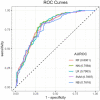Predictors of micronutrient deficiency among children aged 6-23 months in Ethiopia: a machine learning approach
- PMID: 38249594
- PMCID: PMC10796776
- DOI: 10.3389/fnut.2023.1277048
Predictors of micronutrient deficiency among children aged 6-23 months in Ethiopia: a machine learning approach
Abstract
Introduction: Micronutrient (MN) deficiencies are a major public health problem in developing countries including Ethiopia, leading to childhood morbidity and mortality. Effective implementation of programs aimed at reducing MN deficiencies requires an understanding of the important drivers of suboptimal MN intake. Therefore, this study aimed to identify important predictors of MN deficiency among children aged 6-23 months in Ethiopia using machine learning algorithms.
Methods: This study employed data from the 2019 Ethiopia Mini Demographic and Health Survey (2019 EMDHS) and included a sample of 1,455 children aged 6-23 months for analysis. Machine Learning (ML) methods including, Support Vector Machine (SVM), Logistic Regression (LR), Random Forest (RF), Neural Network (NN), and Naïve Bayes (NB) were used to prioritize risk factors for MN deficiency prediction. Performance metrics including accuracy, sensitivity, specificity, and Area Under the Receiver Operating Characteristic (AUROC) curves were used to evaluate model prediction performance.
Results: The prediction performance of the RF model was the best performing ML model in predicting child MN deficiency, with an AUROC of 80.01% and accuracy of 72.41% in the test data. The RF algorithm identified the eastern region of Ethiopia, poorest wealth index, no maternal education, lack of media exposure, home delivery, and younger child age as the top prioritized risk factors in their order of importance for MN deficiency prediction.
Conclusion: The RF algorithm outperformed other ML algorithms in predicting child MN deficiency in Ethiopia. Based on the findings of this study, improving women's education, increasing exposure to mass media, introducing MN-rich foods in early childhood, enhancing access to health services, and targeted intervention in the eastern region are strongly recommended to significantly reduce child MN deficiency.
Keywords: AUROC; Ethiopia; child micronutrient deficiency; machine learning; spatial variation.
Copyright © 2024 Gebeye, Dessie and Yimam.
Conflict of interest statement
The authors declare that the research was conducted in the absence of any commercial or financial relationships that could be construed as a potential conflict of interest.
Figures





Similar articles
-
Employing advanced supervised machine learning approaches for predicting micronutrient intake status among children aged 6-23 months in Ethiopia.Front Nutr. 2024 Jun 11;11:1397399. doi: 10.3389/fnut.2024.1397399. eCollection 2024. Front Nutr. 2024. PMID: 38919392 Free PMC article.
-
Spatial distribution and determinants of micronutrient intake status among children aged 6-23 months in Ethiopia: A Multi-scale Geographical Weighted Regression Analysis.PLoS One. 2025 Apr 29;20(4):e0321113. doi: 10.1371/journal.pone.0321113. eCollection 2025. PLoS One. 2025. PMID: 40299960 Free PMC article.
-
Prediction of acute respiratory infections using machine learning techniques in Amhara Region, Ethiopia.Sci Rep. 2024 Nov 14;14(1):27968. doi: 10.1038/s41598-024-76847-3. Sci Rep. 2024. PMID: 39543232 Free PMC article.
-
Empowering child health: Harnessing machine learning to predict acute respiratory infections in Ethiopian under-fives using demographic and health survey insights.BMC Infect Dis. 2024 Mar 21;24(1):338. doi: 10.1186/s12879-024-09195-2. BMC Infect Dis. 2024. PMID: 38515014 Free PMC article.
-
Spatial distribution and machine learning prediction of sexually transmitted infections and associated factors among sexually active men and women in Ethiopia, evidence from EDHS 2016.BMC Infect Dis. 2023 Jan 23;23(1):49. doi: 10.1186/s12879-023-07987-6. BMC Infect Dis. 2023. PMID: 36690950 Free PMC article.
Cited by
-
Employing advanced supervised machine learning approaches for predicting micronutrient intake status among children aged 6-23 months in Ethiopia.Front Nutr. 2024 Jun 11;11:1397399. doi: 10.3389/fnut.2024.1397399. eCollection 2024. Front Nutr. 2024. PMID: 38919392 Free PMC article.
-
Machine Learning Approach for Predicting the Impact of Food Insecurity on Nutrient Consumption and Malnutrition in Children Aged 6 Months to 5 Years.Children (Basel). 2024 Jul 2;11(7):810. doi: 10.3390/children11070810. Children (Basel). 2024. PMID: 39062259 Free PMC article.
-
Spatial distribution and determinants of micronutrient intake status among children aged 6-23 months in Ethiopia: A Multi-scale Geographical Weighted Regression Analysis.PLoS One. 2025 Apr 29;20(4):e0321113. doi: 10.1371/journal.pone.0321113. eCollection 2025. PLoS One. 2025. PMID: 40299960 Free PMC article.
References
-
- Gebremedhin T, Aschalew AY, Tsehay CT, Dellie E, Atnafu A. Micronutrient intake status and associated factors among children aged 6–23 months in the emerging regions of Ethiopia: a multilevel analysis of the 2016 Ethiopia demographic and health survey. PLoS One. (2021) 16:e0258954. doi: 10.1371/journal.pone.0258954, PMID: - DOI - PMC - PubMed
-
- Harika R, Faber M, Samuel F, Kimiywe J, Mulugeta A. Micronutrient status and dietary intake of Iron, vitamin a, iodine, folate and zinc in women of reproductive age and pregnant women in Ethiopia, Kenya, Nigeria and South Africa: a systematic review of data from 2005 to 2015. Nutrients. (2017) 9:1096. doi: 10.3390/nu9101096 - DOI - PMC - PubMed
-
- EPHI ICF. Ethiopia mini demographic and health survey 2019: Final report. Rockville, Maryland, USA: EPHI and ICF2021.
-
- Eshete T, Kumera G, Bazezew Y, Mihretie A, Marie T. Determinants of inadequate minimum dietary diversity among children aged 6–23 months in Ethiopia: secondary data analysis from Ethiopian demographic and health survey 2016. Agric Food Security. (2018) 7:66. doi: 10.1186/s40066-018-0219-8 - DOI
LinkOut - more resources
Full Text Sources

